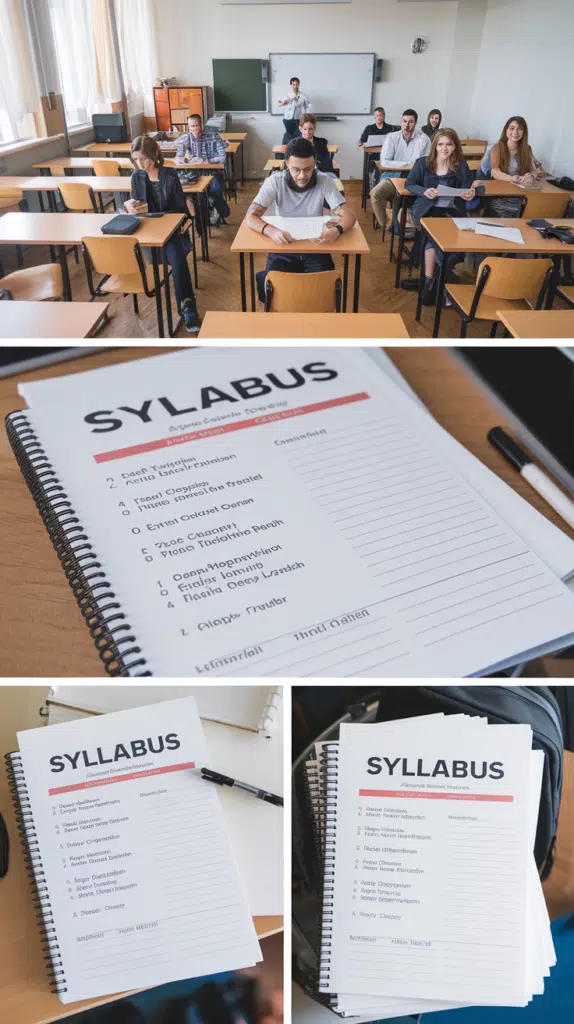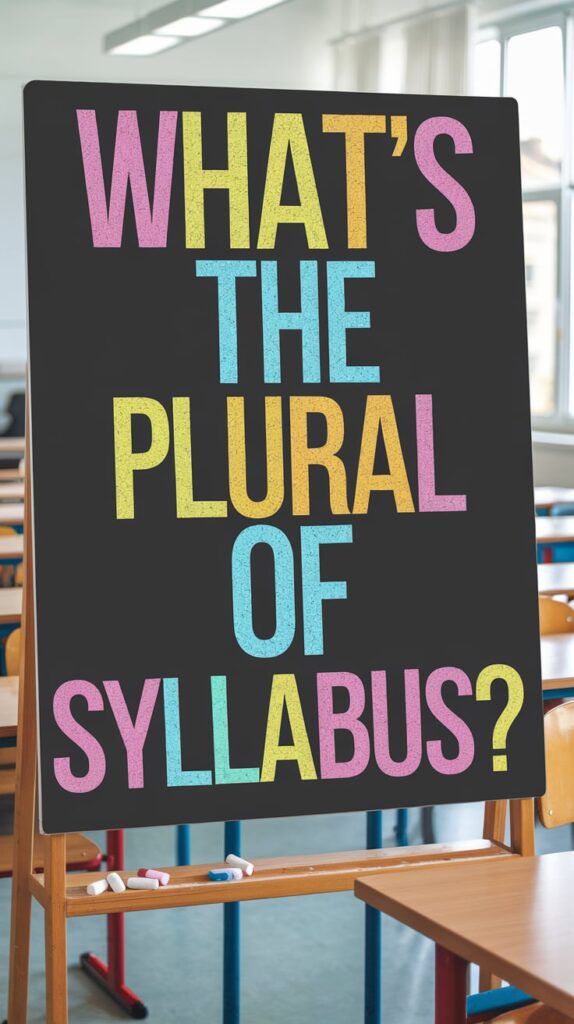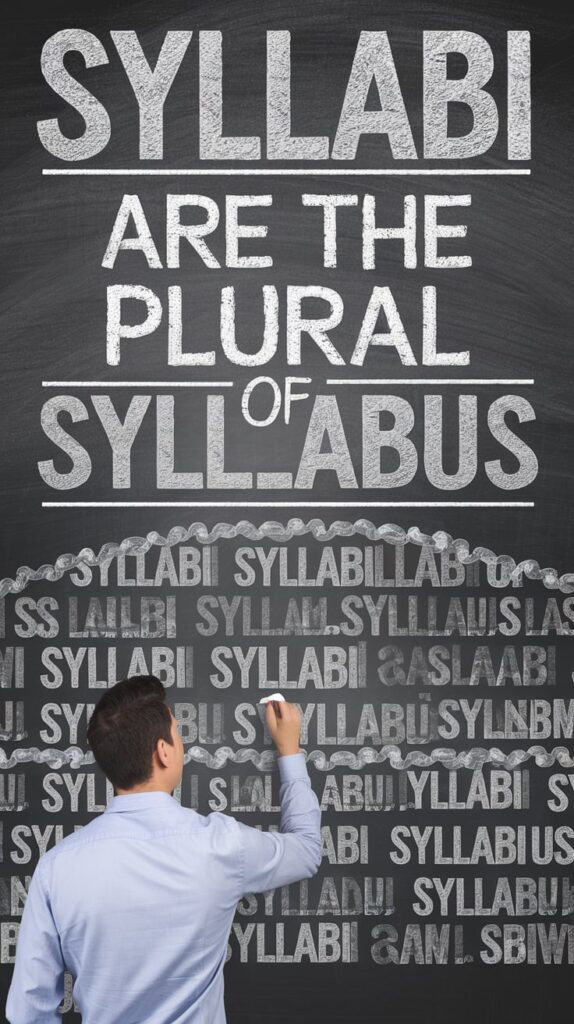Navigating the world of academic terminology can often feel like wandering through a linguistic maze. Among the most common sources of confusion is the word syllabus, and plural of syllabus.
You might find yourself wondering, plural of syllabus? Syllabuses or syllabi? This question isn’t merely academic; it touches on the roots of language, grammatical conventions, and even cultural nuances. Let’s embark on this journey to unravel the mystery of syllabus pluralization while exploring various possessive uses along the way.
read more : Customer’s or Customers’ or Customers – Grammar Beacon
What is Syllabus?
A syllabus is a crucial document in educational settings. It serves as a roadmap for a course, outlining its objectives, materials, and structure. Typically, a syllabus includes:
- Course Description: A brief overview of what the course entails.
- Learning Objectives: Goals that students should achieve by the end of the course.
- Required Readings and Materials: A list of textbooks, articles, and other resources necessary for the course.
In essence, the syllabus guides both instructors and students, ensuring everyone is on the same page. Without it, navigating the academic landscape would be significantly more challenging.
Origins of the Word “Syllabus”
The etymology of the word syllabus traces back to Latin, where it originally referred to a list or label. Over time, it evolved into a term used in academia. A key misunderstanding arose in the 15th century,
where some scholars misinterpreted the term’s connection to the Greek word σύλλαβος (sullabos), meaning “a taking together” or “a capturing.” This linguistic twist adds an interesting layer to the discussion around the word and its pluralization.

The Evolution of Syllabus
The recorded use of “syllabus” dates back to the mid-17th century, initially referring to an outline of a text or a list of topics. As educational systems developed, the term adapted to describe a course’s outline, reflecting changes in teaching methodologies and academic expectations.
Today, syllabuses are fundamental in higher education, guiding both students and professors through complex subject matter.
read more : What Does Compare and Contrast Mean? – Grammar Beacon
Plural of Syllabus: Syllabuses or Syllabi?
Now that we have a solid understanding of what a syllabus is, we can address the critical question: plural of syllabus? Syllabuses or syllabi?
Syllabuses
The term syllabuses is the standard English plural form. It follows the typical rules of English pluralization, where an “-es” is added to the end of the word. This form is particularly common in American English and is widely accepted in academic writing. For example, you might say:
- “The professor handed out the syllabuses for all the courses offered this semester.”
This form is clear and easily understood, making it a safe choice in most contexts.
Syllabi
On the other hand, syllabi adopts a more traditional, Latin-based pluralization. While it’s more commonly used in academic settings, it can lend a formal tone to your writing. For instance:
- “The department chair reviewed the syllabi to ensure they met accreditation standards.”
This usage appeals to those who appreciate a scholarly tone and a nod to the word’s Latin roots.
read more : Hoodie or Hoody – Grammar Beacon

What about Syllaboi?
It’s worth noting that some people mistakenly use the term syllaboi as a plural form. However, this is incorrect. Sticking to syllabuses or syllabi will help you avoid confusion and maintain credibility in your writing.
Some Nouns Ending with ‘-us’ and Their Plurals
To further understand the pluralization of syllabus, it’s helpful to examine other nouns that also end with -us. Here are a few examples:
- Cactus → Cacti
- Focus → Foci
- Alumnus → Alumni
These examples illustrate that many Latin-derived nouns adopt unique pluralization rules. However, it’s important to remember that some can take the standard English pluralization as well. This inconsistency can create confusion, but understanding these patterns can help.
Other Examples
- Virus → Viruses (standard pluralization)
- Octopus → Octopuses or Octopi (both forms are accepted)
- Status → Statuses or Stati (again, both are in use)
As you can see, plural forms can vary widely based on their origins and common usage.
read more : the Past Tense of Swing – Grammar Beacon
Examples in Context (Singular and Plural of syllabus)
To further clarify the differences between syllabus, syllabuses, and syllabi, let’s consider some examples in context.
Singular (“Syllabus”)
The syllabus for the literature course was detailed and comprehensive.
Here, the singular form refers to one specific course outline.
I reviewed the syllabus before enrolling in the class.
In this instance, a student examines the syllabus to understand what the course entails.
After discussing the syllabus with the class, the professor made several updates based on student feedback.
This shows how a syllabus can evolve based on interaction.

Plural (“Syllabuses”)
The administration released the syllabuses for the upcoming semester last week.
This statement indicates that multiple course outlines are now available.
Each department must submit its syllabuses by the end of the month.
Here, multiple departments are required to provide their respective course outlines.
The school’s syllabuses are all available online, allowing students to plan their schedules efficiently.
This emphasizes the accessibility of information in a digital age.
Plural (“Syllabi”)
The professors collaborated to ensure that the syllabi met accreditation standards.
This example emphasizes the collective effort of educators to meet quality criteria.
Students can download the syllabi from the online portal.
This statement indicates that students have access to various course outlines.
When comparing the syllabi, I noticed significant differences in assignment deadlines between the courses.
This illustrates how analyzing syllabi can help students manage their workload.
read more : Other Ways to Say Have a Nice Evening – Grammar Beacon
Understanding Possessives in Context
Possessives can add richness and clarity to your writing, especially in academic contexts. Let’s explore possessive uses related to syllabuses and syllabi, demonstrating how to effectively communicate ownership and relationships.
Possessive Uses with Syllabus
The professor’s syllabus: This indicates that the syllabus belongs to the professor.
Example: “The professor’s syllabus outlines the requirements for the course.”
The students’ syllabus: Here, it suggests that the syllabus is shared among the students.
Example: “The students’ syllabus contains important deadlines.”
The university’s syllabus: This shows that the syllabus is affiliated with the university.
Example: “The university’s syllabus is available on the official website.”
The department’s syllabus: This indicates that the syllabus is specific to a department.
Example: “The department’s syllabus includes unique projects for advanced courses.”
Possessive Uses with Syllabi
The department’s syllabi: This indicates that the syllabi belong to the department.
Example: “The department’s syllabi provide a comprehensive overview of all courses.”
The faculty’s syllabi: This implies that the syllabi are created by the faculty members.
Example: “The faculty’s syllabi include innovative teaching methods.”
The school’s syllabi: This indicates that the syllabi are part of the school’s curriculum.
Example: “The school’s syllabi reflect the latest educational standards.”
The students’ syllabi: This suggests that multiple students are referencing their own syllabi.
Example: “The students’ syllabi highlight various projects they need to complete.”
read more : Plurals of ‘Ox’ and ‘Fox’ – Grammar Beacon

Synonyms for the Word “Syllabus”
Expanding your vocabulary is crucial for effective communication. Here are some synonyms for syllabus, along with contexts in which they might be used in the plural of syllabus.
Formal Synonyms
Course Outline: This is a straightforward and widely recognized term in academia.
Example: “The course outline was distributed during the first class.”
Curriculum Guide: Often used to describe the broader structure of courses within a program.
Example: “The curriculum guide outlines the learning outcomes for each subject.”
Learning Guide: A term that may encompass various educational resources.
Example: “The learning guide helps students navigate the course materials.”
Course Compendium: This suggests a more comprehensive collection of materials and information.
Example: “The course compendium includes all readings, assignments, and exams.”
Informal Synonyms (Use with Caution)
Course Handout: A more casual term often used for one-time distribution.
Example: “The course handout provided a quick overview of expectations.”
Course Packet: Typically refers to a bundled collection of materials.
Example: “The course packet included articles and essays for review.”
Course Roadmap: Suggests a guide for navigating a course but is less formal.
Example: “The course roadmap outlines key milestones throughout the semester.”
Course Cheat Sheet: This informal term implies a simplified version of essential information but may not be suitable for formal contexts.
Example: “The course cheat sheet highlighted the most critical concepts.”
The Importance of Context
When using synonyms, consider your audience. In academic settings, opting for more formal language is generally advisable. However, in casual discussions or peer-to-peer communications, informal terms can create a more relaxed atmosphere.
Cultural Nuances in Language Use
Language reflects cultural attitudes, and the choice plural of syllabus between syllabuses and syllabi can also carry cultural weight. For instance, in American English, the preference for “syllabuses” aligns with a more straightforward approach to pluralization.
Conversely, British English may lean more towards “syllabi,” reflecting a traditional appreciation for Latin roots.

Language and Grammar Evolution
The evolution of language is a dynamic process influenced by cultural shifts, technological advancements, and educational practices. As education becomes more global, understanding these nuances will enhance your communication skills and cultural awareness.
Regional Variations
Awareness of regional differences is essential, especially if you work or study in diverse environments. Here’s how the pluralization might differ:
- United States: Generally favors syllabuses in everyday use but recognizes syllabi in academic contexts.
- United Kingdom: Tends to use syllabi more frequently, reflecting a connection to classical language traditions.
Bridging Cultural Gaps
When discussing academic topics with individuals from different backgrounds, it’s crucial to be mindful of these variations. Using the preferred term for your audience will help facilitate smoother communication and foster understanding.
The Role of Technology in Education
The rise of online learning platforms has transformed how syllabuses are distributed and utilized. Many institutions now provide digital syllabuses, making it easier for students to access course materials and updates.
This shift has also led to a more interactive approach to syllabus creation, allowing students to engage with content more dynamically.
Digital Syllabuses: A New Era
With the increasing reliance on technology, syllabuses are no longer static documents. Many professors now use online platforms to update syllabi in real time, incorporating:
- Interactive Elements: Links to online resources and multimedia content.
- Dynamic Schedules: The ability to adjust due dates and assignment details as the course progresses.
- Collaborative Features: Options for students to contribute to discussion boards related to syllabus topics.
Benefits of Digital Syllabuses
- Accessibility: Students can access syllabi from anywhere, making it easier to stay informed.
- Flexibility: Updates can be made quickly, allowing for adjustments based on class progress or unforeseen circumstances.
- Engagement: Interactive features can make the learning experience more engaging and encourage student participation.
Conclusion
To sum it up, understanding plural of syllabus? Syllabuses or syllabi? involves not just grammar but also cultural context and linguistic evolution.
Both syllabuses and syllabi are correct, with their usage largely depending on your audience and context. Additionally, the exploration of possessive forms adds another layer of richness to our understanding of this essential academic term.
By familiarizing yourself with the nuances of pluralization, synonyms, and cultural considerations, you’ll enhance your communication skills and academic writing.
Whether you’re a student, educator, or professional, mastering these elements will serve you well in your academic journey.

Sources
For further reading on the topic, you might find these resources useful:
- Merriam-Webster Dictionary on syllabus.
- Purdue OWL on academic writing.
- Journal of Language and Linguistics on the evolution of language and educational terms.
With this comprehensive guide, you’re now equipped to confidently navigate the complexities of academic terminology!

James Logan is a seasoned blogger and language enthusiast behind Grammar Beacon. With years of experience in grammar and writing, James shares his expertise through insightful and engaging content. His passion for clear communication and linguistic precision shines in every post, making complex grammar concepts accessible and enjoyable for readers. Follow James for expert advice and tips to refine your writing skills.







